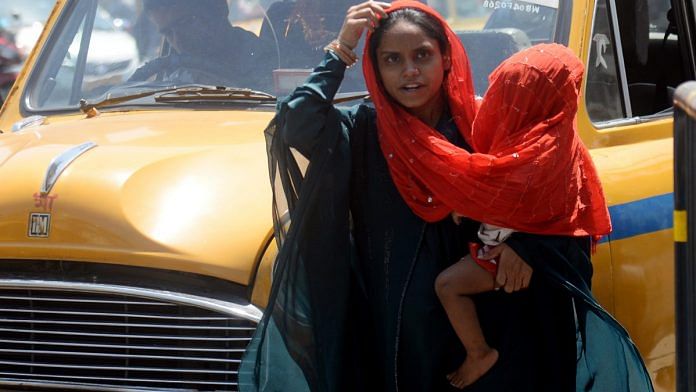New Delhi: Current indices mapping India’s vulnerability to climate change are failing to adequately capture the impact of heatwaves, which could in turn hinder the achievement of sustainable development goals (SDGs), according to a research paper published Wednesday.
The study by researchers at the University of Cambridge, Yale University & Caltech, which cites Delhi as being exposed to dangerous levels of heat, brings out “blind spots” in current climate vulnerability.
The research, published in the peer-reviewed journal PLOS Climate, cites the example of the Department of Science and Technology’s Climate Vulnerability Index (CVI). The index, the study says, classified states such as Haryana and Punjab, which saw temperatures rise 6-7 degrees Celsius above normal last year, as “low-risk” areas.
Researchers were able to establish their findings by comparing the CVI data with a heat index, which is based on the deadly heatwaves that ripped through the country last year, killing at least 25 people. Linking the two “identifies more of India’s vulnerability and provides an opportunity to rethink India’s climate adaptation policies,” they write in the paper.
The study says that according to the index, about 45 per cent of the country is moderately exposed to the impacts of climate change. But when linked to a heat index, the risk is more extreme and widespread, with 90 per cent of the country falling within the “extremely cautious” or “danger” range.
India, which is among the most vulnerable countries in the world to climate change, is bracing for another scorching summer, with temperatures having crossed 40 degrees in several parts of the country over the past week.
The findings raise questions about India’s ambitions of achieving sustainable development, with extreme heat threatening to upend progress towards the SDGs.
The country is already a laggard when it comes to achieving the 17 SDGs it has adopted. The latest ranking shows that India slipped three spots in 2022 compared to the previous report, ranking 120th out of 192 countries.
“Most of the 11 SDGs India lags on are critically related to climate action. India’s preparedness and performance on SDG 11 (sustainable cities and communities) and SDG 13 (climate action) has declined significantly. This becomes severe due to the strong correlation between these SDGs,” the paper says.
Formulated in 2015 by the United Nations General Assembly (UNGA) as part of the Post-2015 Development Agenda, SDGs are a list of 17 goals that are meant to serve as a “shared blueprint for peace and prosperity for people and the planet, now and into the future”.
Also Read: Climate change is leading to more lightning strikes. Policymakers need to take note to save lives
‘Incorrect’ assessment
While the CVI fails to capture risks of extreme heat exposure, it demonstrates that “heatwaves put more people at extreme climate risk across India” than previously thought.
In underestimating the burden of heat on climate vulnerability, India may “need to reconsider its assessment of climate vulnerabilities to meet the SDGs,” the paper says.
For example, Andhra Pradesh falls in the “extreme danger” range of the heat index, which would affect SDG 3 (good health and well-being) and SDG15 (life on land). “However, these SDGs are considered moderate in the CVI classification,” the study says.
In West Bengal, which is also at risk of exposure to extremely dangerous heat, SDG 3, SDG 15, SDG 5 (gender equality), and SDG 8 (decent work and economic growth) were already “in the high values indicating these SDGs were already stressed in the state. With heatwaves, their fulfillment can further be challenging.”
The paper estimates that heat will impact income shares from natural resources, marginal and small landholdings, adaptive livelihood capacity through MGNREGA, yield variability of food grains, vector-borne diseases and water-borne diseases “at a grander scale,” than is currently perceived by the CVI.
‘Whole-system treatment of climate vulnerabilities’
The study scaled down its analysis to the district level for the city of Delhi in order to assess the impacts of heat on sustainable development in urban areas.
Delhi’s State Action Plan on Climate Change shows that the South and North East districts are the most vulnerable to climate impacts, but the heat index shows that 100 per cent of the city is exposed to dangerous levels of heat.
“Some of the critical variables in Delhi that will aggravate heat-related vulnerabilities are concentration of slum population and overcrowding in high heat index areas, lack of access to basic amenities like electricity, water and sanitation, non-availability of immediate healthcare and health insurance, poor condition of housing and dirty cooking fuel (traditional biomass, kerosene and coal),” the paper says.
Reducing these vulnerabilities needs “structural interventions through the fulfillment of SDG 3 (good health and well being), 9 (industry, innovation and infrastructure), 11 (sustainable cities and communities) and 10 (reduced inequalities), which are currently missing in India’s SDG focus areas”, it added.
Last month, Delhi-based think tank Centre for Policy Research released its own study, which found that existing Heat Action Plans from 18 states were “underfunded, insufficiently transparent and not built for the local context”.
“India can begin appropriate adaptation planning only with a whole-system treatment of its climate vulnerabilities,” the paper concludes.
(Edited by Uttara Ramaswamy)
Also Read: High Seas Treaty historic but climate change is upon us. India as G20 president can act



